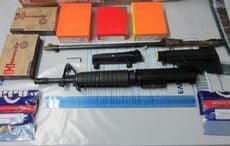A shocking recording made by a woman who spent 36 years at the notorious Mother and Baby Home in Tuam, County Galway has confirmed there is an unmarked grave on the grounds of the institution.
Julia Devaney reportedly entered the Mother and Baby Home in Tuam as an orphan when she was nine years old and spent 36 years there (later working as a domestic servant for the Bon Secours nuns) until the home finally closed in 1961.
In taped interviews originally recorded in the 1980’s (but which have been published by The Daily Mail for the first time this week) Devaney gives a startling account of daily life in the home.
To bring her words to a the world’s attention local historian Catherine Corless (whose research made international headlines when she revealed the names of the 796 children who died in the home from 1925 to 1961) has spent months meticulously transcribing Devaney’s interview.
Devaney said: “Scores of children died under a year and whooping cough was epidemic. Sure they had a little graveyard of their own up there. It’s still there, it’s walled in now. I don’t remember seeing any stillbirths. If the child died under a year, there were always inquiries. There wasn’t as much about it if the child was over a year.”
“Under a year old, the inspectors would put it down to neglect. They would look upon it as natural if the child was over a year because the child would be more open to diseases.”
Records show that the infants at the home frequently suffered from malnutrition and neglect, while others died of measles, convulsions, TB, and pneumonia.
“Nuns had very little contact with the children, they wouldn’t even know their names,” Devaney continued. “The children were whacked at school, they had no sympathy any side, they had no one.”
Corless reportedly believes that the ongoing Commission of Investigation into Mother and Baby Homes should have a copy of Devaney’s transcript and so she plans to give it to Judge Yvonne Murphy, chairwoman of the commission in the New Year.
Corless told the Mail: “Julia was in the home all of her life, she knew what happened there.”
The testimony of an eyewitness supports previous claims about the existence of the unmarked grave site and what exactly the Bon Secours nuns and the local council knew about the situation. Devaney died two decades ago and was a well known member of the community in Tuam.
When the home finally closed in 1961 the nuns gave her a job in the gardens of the Grove Hospital (which they also owned) until she met and married John Devaney. The couple lived out their days in Tuam and Devaney gave the recently rediscovered interview to one of her gardening clients who owned a shop in the town.
Devaney, who had no children of her own, constantly remarks that it was apparent to her that the orphans in the home meant nothing to the nuns.
“It was not like a home, they’d be better off with a drunken father at home. It was an awful lonely old hole. Not natural, unnatural.”
Signs of chronic neglect were everywhere, Devaney adds. “The children had a language all their own, they didn’t talk right at all, nobody to teach them, nobody to care. When the children came home from school they got their dinner and then their hair was fine-combed for nits and fleas.”
“They got tea, bread and butter and cocoa for their supper. The little ones went to bed summer and winter at 6pm. They had swings and see-saws, but when I look back they were very unnatural children, shouting, screeching.”
Years after the home closed Devaney believed she could still hear them when she visited the former site. The sounds haunted her she said.
“The Home children were like chickens in a coop, bedlam, screeching, shouting in the toddlers’ room. They never learned to speak properly, ’twas like they had a language all of their own, babbling sounds!”
“The nuns made no effort to develop their minds. The mothers were told to feed them and clean up after them and put them on the pots. I think they spent most of their time sitting on the pots. The children were so mischievous that they would throw the pots and blankets out the window just for something to do.”
“I always noticed that the children were awful small for their age. Always undersized children. Some of the children wouldn’t use spoons, but use their fists to lift the porridge out of the mugs, and they would get a whack. There were never any toys or books, never any effort to teach them anything. I’m sure a lot of them are in mental homes now…Nobody loved the children… The children would be trying to get up on your knees and trying to love you, looking for affection.”
The memory of the cruelty and neglect troubled her conscience, she said.
“I have terrible regrets for the children, I feel a sense of shame that I did not create a war, but then again what could I have done? It makes me lonely when I walk up to the Home site now, I think I can still hear the Home children shouting and laughing.”
Delaney was reportedly interviewed by Rebecca Millane, also from Tuam, who ran a shop in the town. According to the Mail the interview was never broadcast or published until this week, after Catherine Corless’s transcribed it word for word.
The tapes prove that the horrifying legacy of decades long cruelty and neglect at the home was widely known in the community, decades before any revelations came to light in the press.




Comments